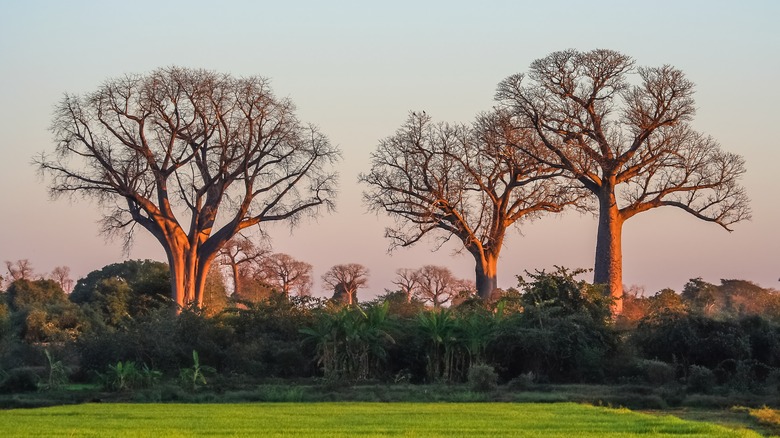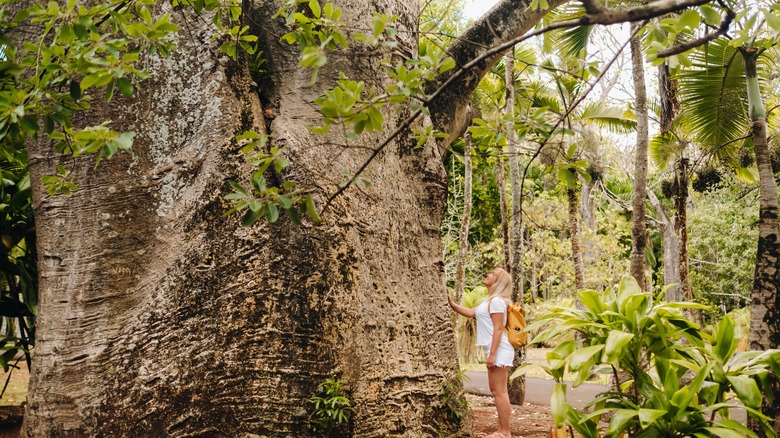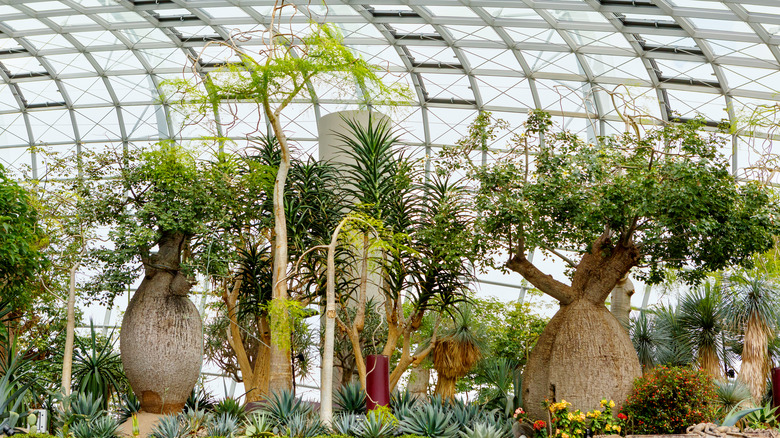Can You Grow A Baobab Tree In The US? Here's How To Plant Inside Or Outdoors
A baobab tree is truly a wonderful sight when viewed in its natural habitat. There are only eight species in total with six native to Madagascar, one native to Africa, and one native to Australia. It can only be grown outdoors in USDA hardiness zones 10 through 12 as it's extremely frost-sensitive. What's special about these trees is that they can live for thousands of years and can reach a height of 100 feet. Even more impressive is that the trunk alone can reach a width of 20 feet and the canopy can reach 60 feet wide. The largest baobab tree growing in the U.S. can be found at the University of Hawaii at the Manoa campus.
But this tree is not only noted for its majestic stature. It's also an important food source for people living in West Africa. The leaves, fruits, and seeds of the African baobab tree are all edible. The fruit is commonly known as monkey bread and it has dry and mealy pulp. While only gardeners living in warm regions can grow a baobab tree outdoors, those in cooler climates can grow this tree indoors during winter and bring it outdoors during summer. It's also common for these trees to be grown as bonsai, and you might be interested in learning how to grow a bonsai tree if you don't have the space or climate to plant it outdoors. Here's how you can grow this tree both outdoors and indoors.
How to grow a baobab tree outdoors
If you're lucky enough to live in a warm climate that doesn't experience temperatures below 35 degrees Fahrenheit, you can plant a baobab tree in your garden. But be mindful that this tree will get quite large and its growth rate is very fast. For example, the tree can grow between 2 to 4 feet in the first year and up to 8 feet in the second year. But it can take more than 16 years for the baobab tree to reach its full height.
If you have the space, you want to choose a sunny spot and make sure that the soil is well-drained. The baobab stores water in its trunk so it does not handle having wet feet and prefers a relatively dry, hot climate. To compliment your baobab tree, you might also be interested in other drought-resistant plants that will thrive without much water. The baobab tree also prefers rocky soils with a pH of 6.6 to 7.5. After planting your young tree, water it quite sparingly in spring and summer – no more than twice a week if needed. The tree is deciduous and becomes dormant over the fall and winter, so it should be kept fairly dry. These trees don't need any other type of special care and are virtually maintenance-free.
How to grow a baobab tree indoors
For gardeners in cooler climates, baobab trees can be grown indoors in pots to protect them from extreme cold and frost. But to encourage your tree to grow, you want to take it outdoors during the hotter months and place it in a lovely sunny spot. When selecting a pot for your baobab tree, make sure that it's relatively deep because baobab trees produce a long tap root as they start to grow from seed. Growing your tree in a pot will also restrict its size as the top growth is likely to be proportionate to the root growth in the pot. Also, make sure that the pot has plenty of drainage holes.
Choose a growing medium that is free-draining and not too rich in nutrients. You can use a cactus or succulent mix and amend this with some river sand and crushed pumice or perlite. Baobab trees can be grown from seeds or cuttings but you might want to understand how to grow and care for succulent cuttings before you give this a try. Only water your tree when the soil has been allowed to dry out. Remember that the trunk holds water so the tree can easily survive dry spells once the trunk has had time to develop. During winter, watering should be minimal. When you move the tree outdoors over summer, water deeply, allowing the excess to drain away. Only water again when the soil is dry.


